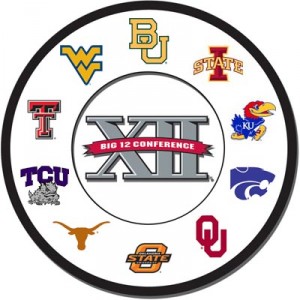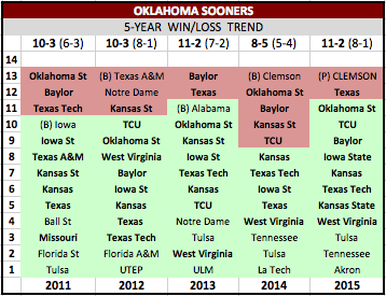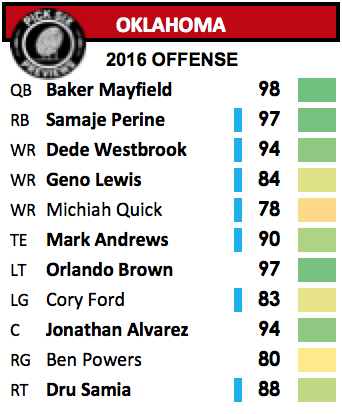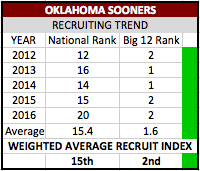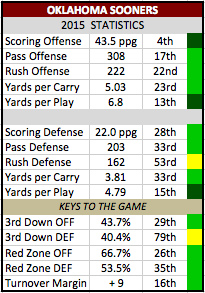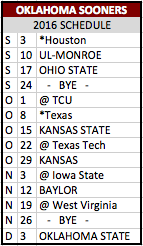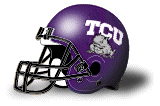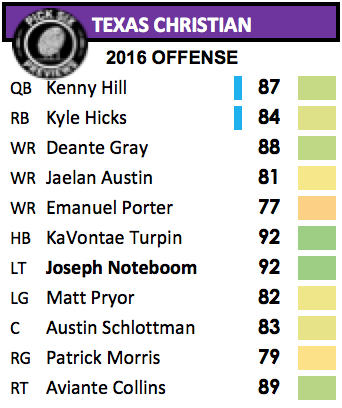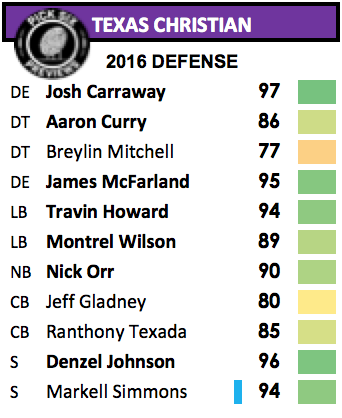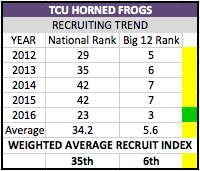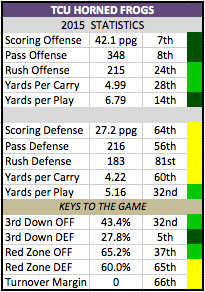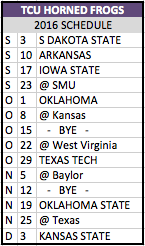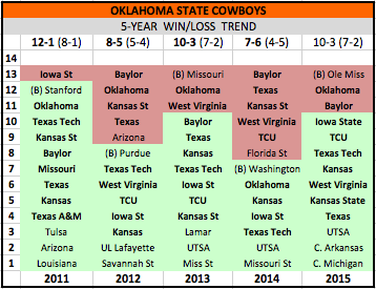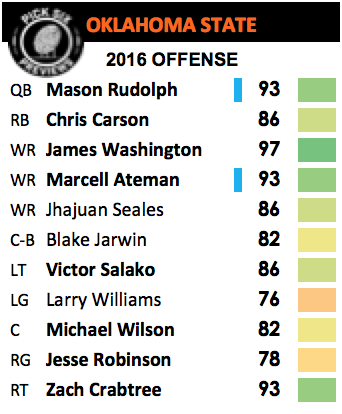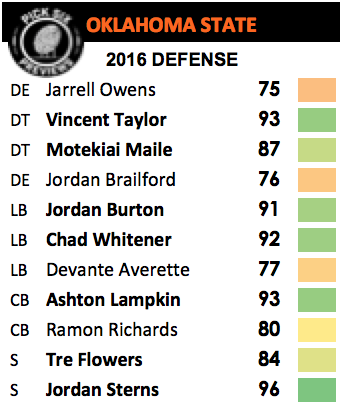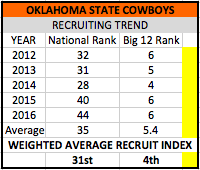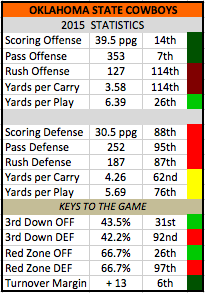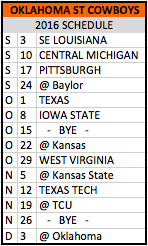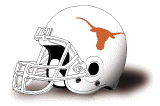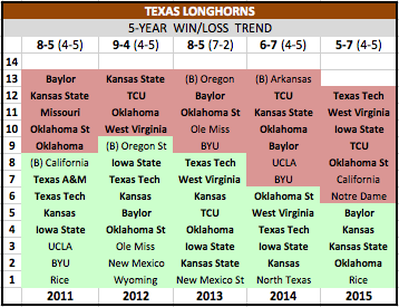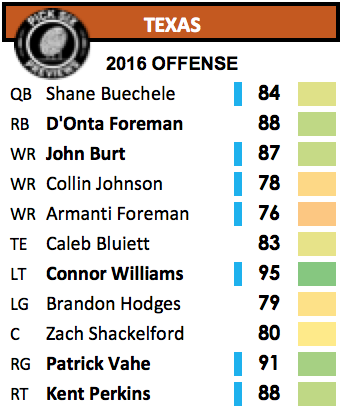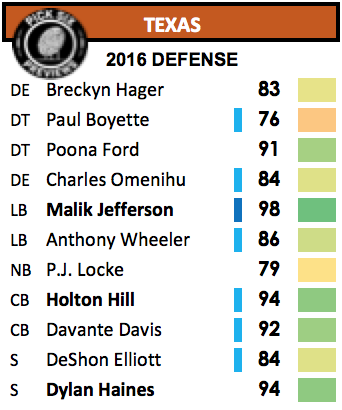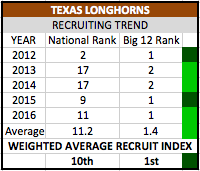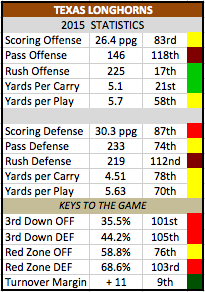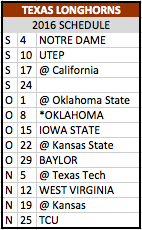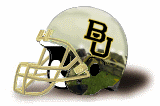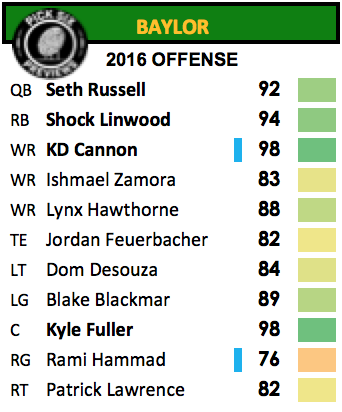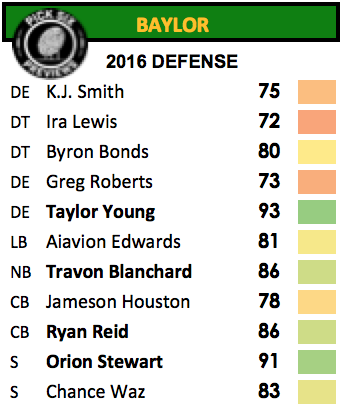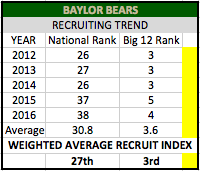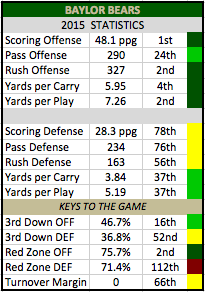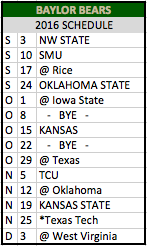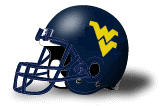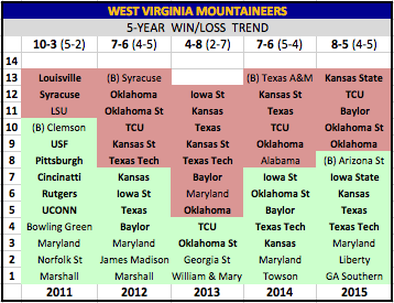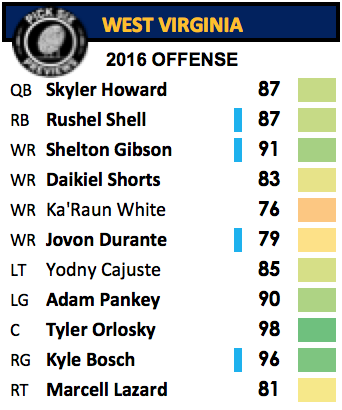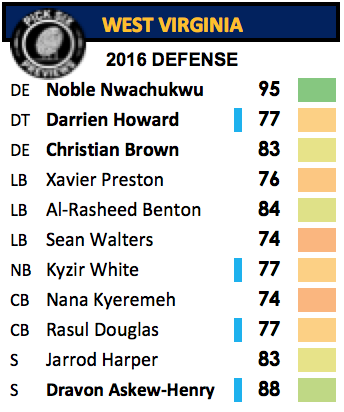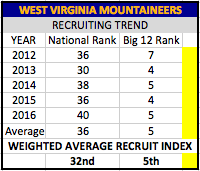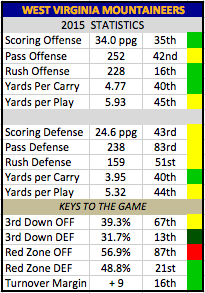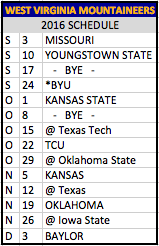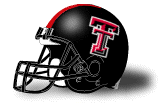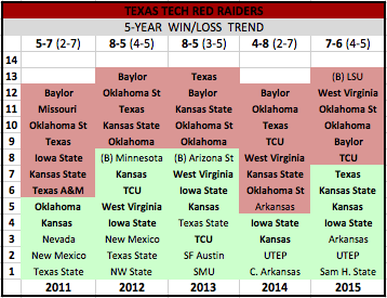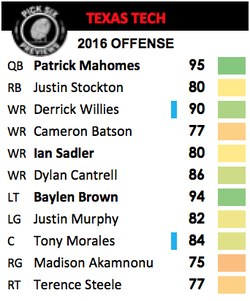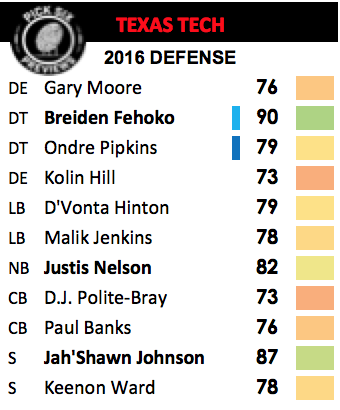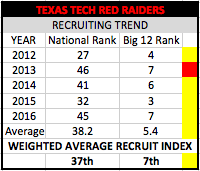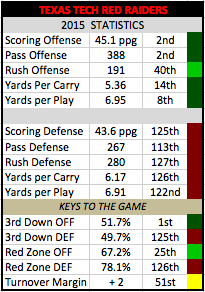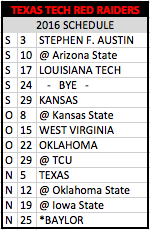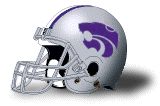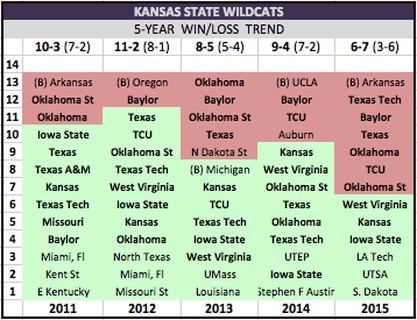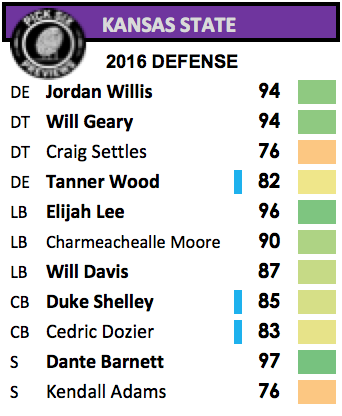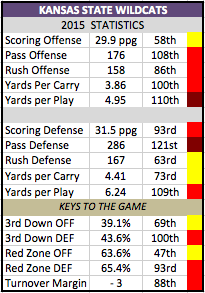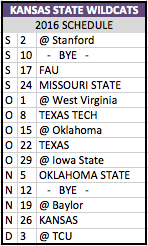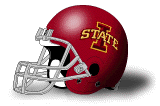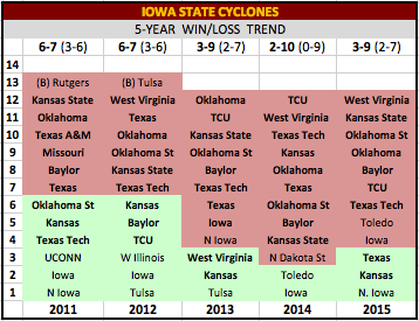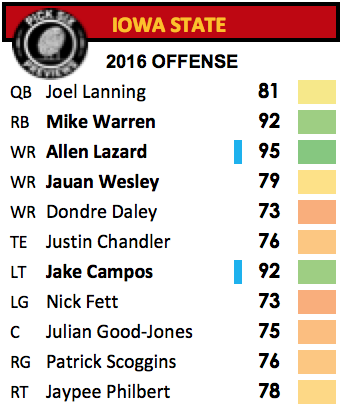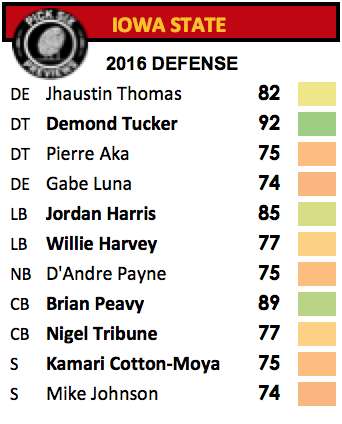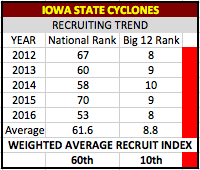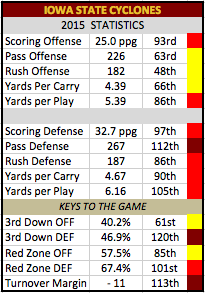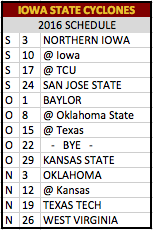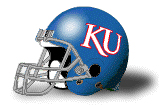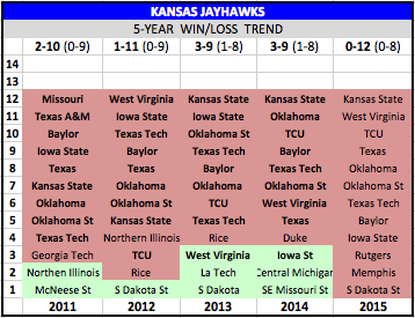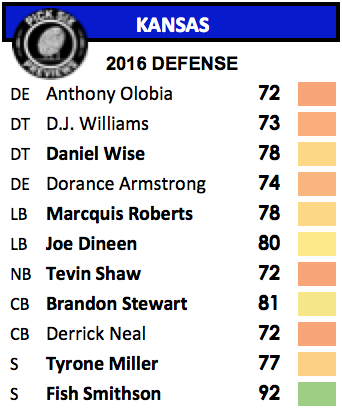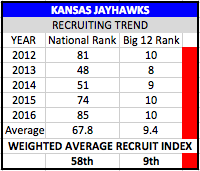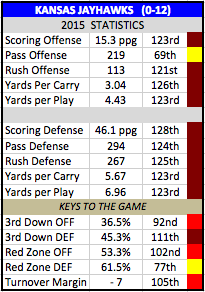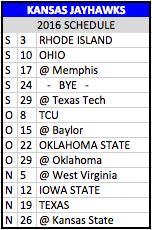1. OKLAHOMA SOONERS
Order was restored in Norman last season as the Oklahoma Sooners captured their ninth Big 12 conference title and earned a spot in the College Football Playoff. Repeating as a conference champion is never easy, but with the weapons Bob Stoops has returning, it’s hard to find a reason the Sooners won’t.
OU was consistently excellent last year as just three of its 13 contests were decided by one possession. On top of that, only five were decided by less than 20 points. Even with the talent coming back, there was an exodus of playmakers leaving plenty of holes to fill if the Sooners hope to replicate that dominance. Perhaps the greatest void is at wide receiver after go-to offensive weapon Sterling Shepard was selected 40th overall by the New York Giants in the 2016 NFL Draft. In addition, the pass rush has perhaps the biggest needs as the Sooners must replace five of their top six linebackers (those five combined for 37 tackles for loss, 12 sacks and 11 passes defensed).
Few things in life are as consistent as a Gary Patterson defense, and the 2015-16 season was no different. Despite question marks, depth issues and inexperience, Patterson’s club finished fourth in the conference in total defense while relying on a bevy of freshmen. One of those freshmen, Mike Freeze, shined in preseason practice before being named starter at middle linebacker. Shortly in the season, Freeze excused himself for personal reasons and never rejoined the Horned Frogs, ultimately transferring in the offseason. If inexperience and depth weren’t enough, TCU suffered the injury bug, which claimed four starters, including James McFarland (who will be remembered for his heroics against Ole Miss in the Chick-fil-a Bowl) and Sammy Douglas. Trevone Boykin lived up to the Heisman hype early in the season before also sustaining an injury late in the season against Oklahoma State. The injury before heading into Norman derailed the rest of the season. Boykin never fully recovered and was suspended prior to the Alamo Bowl.
TCU had struggled in the Big 12 during its early tenure, but the installation of a new offensive system rejuvenated the Horned Frogs, who improved to 23-3 over the past two seasons, including bowl wins over Ole Miss and Oregon, the latter in dramatic comeback fashion. TCU was robbed of a potential playoff run in 2014 and injuries stunted the Horned Frogs in 2015, but TCU has emerged as an annual Big 12 contender and the team to watch possibly dethrone Oklahoma in 2016.
Following a rough rebuilding year in 2014, Oklahoma State seemingly limped into this past season. Despite the offseason dismissal of the highly athletic (and now NFL return man) Tyreek Hill, the Cowboys weren’t for lack of firepower. The backfield welcomed JUCO All-American Chris Carson, who spurned Georgia for Stillwater, and had the conference’s deepest receiver corps. A deeper and more experienced offensive line looked ready to improve on a dreadful campaign in 2014, which was a large reason the offense had stalled much of that season.
Improvements came slowly, though. Gundy’s Cowboys won each of their first 10 games, but only five came by more than a touchdown. Twice in the nonconference OSU looked less than impressive, and during conference play had to hold off Texas and come back against Kansas State, West Virginia, Texas Tech and Iowa State. A blowout of TCU looked to be a turning point for the Cowboys (the only team to beat TCU with starting quarterback Trevone Boykin) heading into the toughest part of the schedule. However, a trap game at Iowa State nearly tripped up Oklahoma State before hosting Baylor. The Cowboys allowed two long touchdowns early against Baylor and the Cowboys never led a quarter of play after in blowout losses to OU and Ole Miss in the Sugar Bowl.
4. TEXAS LONGHORNS
The narrative seems to gain more steam each and every year in Austin. Are the Texas Longhorns back? Will Charlie Strong get the program to the level it used to be?
After opening last season with a 38-3 drubbing at the hands of Notre Dame, Strong demoted offensive co-coordinators Joe Wickline and Shawn Watson, promoting receivers coach Jay Norvell to the play-calling chair. None are with Texas in 2016 because of the dramatic offensive inconsistency. So Strong went and picked his guy. Sterlin Gilbert takes over the reigns as offensive coordinator, bringing a much-needed identity from Tulsa — the spread. A lineup that was filled with freshmen and sophomores a year ago gains another year of experience. The upside they flashed at times could point to a tremendous sign that the good just might become great. Restoring the Longhorns back to national prominence was not an overnight task and Strong has them at its doorstep with his pieces in place. The season opener, September 4 versus Notre Dame, will go a long way in revealing the path Texas will take in 2016.
When Art Briles arrived in Waco in 2008 fresh off several successful seasons with Houston, Baylor was the Big 12 cellar dweller. The Bears were the laughingstock of the conference, winning only a handful of conference games since joining the league at its inception in 1996. Briles’ brilliantly developed offensive gameplan along with the commitment of Robert Griffin III transformed the Bears. Griffin brought home the Heisman in 2011 and Baylor claimed its first conference title in 2012.
Fast forward to 2016. Baylor is now the Big 12’s black eye. Briles and university president Ken Starr were fired amid investigation of a sexual assault cover-up that spanned both the university and local police. The scandal cost interim coach Jim Grobe much of the highly-touted incoming recruiting class, many of whom would likely have been called on to fill immediate needs. News didn’t get much better as the investigation revealed some of the findings. Backup quarterback Jarrett Stidham, supposedly escaping the scandal, transferred out. Third string quarterback and converted wide receiver Chris Johnson announced his decision to transfer earlier in the season, leaving the cupboard bare behind returning starter Seth Russell. In an effort to control the situation, Grobe announced it was his decision to keep Briles’ staff, many of who were implicated in the investigation. His efforts only led to more questions about the program’s integrity and Grobe’s questionable decision making. This story, along with conference expansion, will follow Baylor and the Big 12 throughout the season. Any lingering effects to players may be seen on the field, which could be disastrous in a competitive league.
Talk about Dr. Jekyll and Mr. Hyde. Last season, the West Virginia Mountaineers transformed from Jekyll into Hyde and back. They played like a top-20 team or better in September and November, beating teams they should and doing so convincingly.
Then October happened. WVU got whipped by Oklahoma and lost the heart of its defense in safety Karl Joseph, leading to the domino effect. After setting the bar high, the Mountaineers failed to clear it as a 3-0 start quickly turned into a 3-4 mark. Athleticism has always been a forte of Dana Holgorsen coached teams as players must keep up with his tempo. Once again, he has the pieces in place to make something special happen in Morgantown, but the brutal travel the Mountaineers face in the Big 12 illuminates issues such as consistency and staying healthy. As always, the offense should be explosive. Not having running back Wendell Smallwood, who rushed for 1,519 yards a year ago, creates new opportunities and the players that will step in have experience. Meanwhile, the defense is a whole different story and we’ll get to that.
Along the left column of this preview you’ll see the stat boxes that we compile every season, which are meant to visualize strengths and weaknesses of the team’s previous season. Of all 65 boxes we created, this is on the short list in terms of the largest contrast from offense to defense. Boston College and Missouri were all defense with little to no offensive production (BC lost a game 3-0). But on the other side of the spectrum are the pinball offenses such as Texas Tech and Washington State. Texas Tech scored 52 points against TCU and 53 points against Oklahoma State – and lost both games!
This severe dichotomy has put a ceiling on Texas Tech during the Kingsbury era; in his three seasons as head coach they have failed to pull off a conference winning record. The praise is worthy for the insane offensive production, but the soft defense ends up basically cancelling it out. Can the offense sustain the 45 points per game output (2nd nationally), and can the defense (3rd worst nationally) improve enough to make it count?
If you are new to the sport of college football, one of the most proven rules is to never underestimate 76-year old Bill Snyder. In what has become known as the gold standard of program rebuilds, he made consistent winners out of a Kansas State program that went just 3-40-1 in the 4 years before his 1989 arrival in Manhattan. That he made Kansas State a powerhouse in the 1990s and early 2000s is nothing short of a miracle. He stepped away from KSU for three years and all his hard work crumbled down – but he came back again to rebuild and brought the Wildcats to back-to-back double-digit win seasons in 2011 and 2012.
That 2012 season was when we were first snakebitten by the Snyder Magic. We launched the site in August 2012, and in our first season preview, I was a seller of Kansas State, placing them below the national consensus due to their several close (lucky) wins in 2011 that I felt would reverse. Our first follower on Twitter, K-State Marty, made sure to remind us each week of our blown pick. While we finished 2012 with the most accurate BCS previews in America, according to Stassen Accuracy who tracks the preseason publications, I’ll still never forget that pick.
And so the Matt Campbell era begins at Iowa State, bringing quite the expectations along with him from Toledo.
Paul Rhoads earned three bowl bids in his first four years, never winning more than seven games in a season. Then he went 8-28, leading to his firing and Campbell’s hire. In fact, the Cyclones have won more than seven games in a season just seven times in nearly 120 years. Stars are in place and that is rarely the case in Ames. However, lack of depth poses a critical question mark for Campbell in his first season, which features a brutal road slate. Campbell’s energy and solid recruiting chops will generate more wins in coming years than the great Cyclones fans are used to. With upgraded facilities and greater resources, Campbell should have the Cyclones turned around in no time.
The Kansas Jayhawks hit the rock chalk bottom last season going 0-12. They should win at least one game in 2016 and that will most likely be the season opener, September 3 versus Rhode Island. From there, it will be a matter of figuring everything else out.
The seven-year collapse culminated in depths so low that there is ultimately no quick road back. Now entering his second year as head coach, David Beaty inherited almost no Big 12 talent when he took over in Lawrence. There is another year of experience, but still not enough talent to take drastic steps. This job is the ultimate definition of a rebuild. But anything will be an improvement from the product the Jayhawks put on the field last season. They were so bad among FBS teams that by many rating systems, KU would have ranked 41st in FCS. Absolutely futile!
|
PICK SIX PREVIEWS ON THE RADIO:
2016 PREVIEW
|
|
|
© 2025 Pick Six Previews LLC. All Rights Reserved. For Informational Purposes Only
Privacy Policy |

